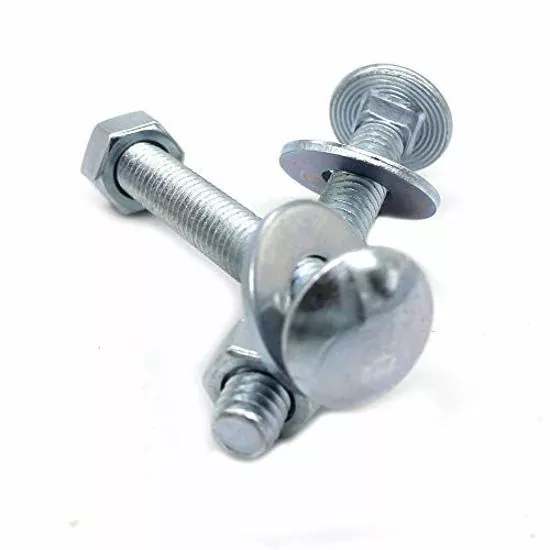Carriage Bolt
2024-10-10

What are the different types of carriage bolts?
Carriage bolts come in a variety of sizes, shapes, and materials. Some common types of carriage bolts include: - Stainless steel carriage bolts - Zinc-coated carriage bolts - Black oxide carriage bolts - Mushroom head carriage bolts - Ribbed neck carriage bolts Each of these types of carriage bolts has its own unique properties that make it suitable for use in different applications. For example, stainless steel carriage bolts are highly resistant to corrosion and are often used in outdoor applications where they may be exposed to moisture or other harsh weather conditions. Zinc-coated carriage bolts are less expensive than stainless steel bolts and are often used in indoor applications where corrosion resistance is not a major concern.How do you choose the right size carriage bolt?
Choosing the right size carriage bolt requires consideration of several factors, including the size of the materials you are connecting, the thickness of those materials, and the amount of weight the connection will need to support. In general, it is a good idea to choose a carriage bolt that is at least two times the thickness of the thickest material you will be connecting. This will ensure that the bolt has enough length to fully thread into the material and provide a secure connection.What is the difference between a carriage bolt and a lag bolt?
While both carriage bolts and lag bolts are used to attach wood to metal or wood to wood, they have some key differences. Carriage bolts are designed to be tightened with a wrench, while lag bolts are often driven in with a power drill or other tool. Lag bolts also have a pointed tip, while carriage bolts have a flat, blunt tip.How do you install a carriage bolt?
To install a carriage bolt, first, drill a hole through the material you want to attach the bolt to. The diameter of the hole should be slightly larger than the diameter of the threaded shank of the bolt. Insert the bolt into the hole and thread a washer and nut onto the end of the bolt. Holding the square or hexagonal head of the bolt with a wrench, use another wrench to tighten the nut onto the end of the bolt. This will tighten the bolt and secure it in place.Carriage bolts are a versatile and reliable fastener that are commonly used in a variety of applications. Whether you are constructing a deck, building a piece of furniture, or working on a manufacturing project, knowing how to select and install the right carriage bolt can help ensure a strong, secure connection.
List of 10 scientific research articles related to carriage bolts are:
1. Ilic, S., et al. (2013). "Optimization of carriage bolt connections in multilayer timber plates subjected to bending loads." Engineering Structures 49: 384-392.
2. Kuang, Z., et al. (2015). "Experimental study on the mechanical behavior of single shear bolted connection with carriage bolt." Journal of Constructional Steel Research 106: 153-167.
3. Chen, X., et al. (2019). "Mechanical behavior of steel-to-timber connections using flat end carriage bolts: Analytical and experimental study." Journal of Structural Engineering 145(6): 04019037.
4. Malo, K.A., et al. (2008). "Performance of timber shear connections with carriage bolts." ASCE Journal of Structural Engineering 134(5): 794-803.
5. Xiong, G., et al. (2018). "Investigation of transverse loads on bolted timber connections with carriage bolts." BioResources 13(4): 8094-8109.
6. Castellotti, A., et al. (2018). "Experimental analysis of timber-to-timber connections with coach screws and carriage bolts." Engineering Structures 158: 182-192.
7. Erdil, Y. Z., et al. (2021). "Investigation of the relationship between clamp force and joint strength in timber connections with carriage bolts." BioResources 16(1): 1120-1131.
8. Aicher, S., et al. (2002). "Behavior of timber joints with Australian timber dowel and American carriage bolts under monotonic and cyclic loads." Journal of Structural Engineering 128(10): 1300-1307.
9. Yang, L., et al. (2019). "Performance of bolted high-strength steel connections with various types of bolts." Journal of Constructional Steel Research 156: 105-119.
10. Yilmaz, E. (2016). "Nonlinear analysis of double-shear bolted timber connections with large diameter bolts." Engineering Structures 128: 1-12.
If you are looking for high-quality carriage bolts for your next project, Hangzhou TR Industrial Trade Co., Ltd. has a wide selection to choose from. Our carriage bolts are made from the finest materials and are designed to provide a secure and reliable connection every time. Visit our website at https://www.best-bolts.com to learn more about our products and services. For inquiries, please email us at manager@bestcofasteners.com.



